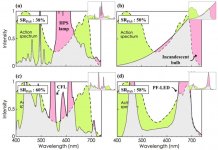Ca++
Well-known member
Far red lessens the plants reaction to blue.
If you have enough blue that the plants are practicing light avoidance (growing squat) then the far red can reduce that. Thus, you could say from trail and observation, that far red makes them stretch. Though the reality is that blue puts the brakes on, and far red is jamming it's foot under the pedal.
It's quite a few cannabis papers coming together, that tells us this from a number of angles. No single paper contains it all. Only one really got to the chemical interference at the depth of our understanding. While they all take some finding, in the piles of older papers saying far red causes stretch, in some unknown species.
Avoiding blue isn't common to all plant types. Not a lot is common. Looking at the response curves on 10 different papers, could show 10 different curves. I'm not sure why there is a need to say just one is correct. Different plant, different absorption. Just look at them. A nice cabbage, with dark thick crinkly leaves, isn't going to take in light like a rose petal. Put each over a torch, and see how much tech you really need, to see this is so. Many of these curves are drawn with little more effort. I actually gave up trying to make arguments with them, as it's just not my work. However the collective weight of knowledge, all pointing in a similar direction, is more than most growers will ever need.
Should I reduce Ca inputs in the final weeks? The plants struggle to take it, so should I counter with more, or just let it be. I reuse coco, so do have reason to keep adding at least some. While too much can actually hinder uptake, a bit like soup.
Random.. but it's been playing on my mind.
If you have enough blue that the plants are practicing light avoidance (growing squat) then the far red can reduce that. Thus, you could say from trail and observation, that far red makes them stretch. Though the reality is that blue puts the brakes on, and far red is jamming it's foot under the pedal.
It's quite a few cannabis papers coming together, that tells us this from a number of angles. No single paper contains it all. Only one really got to the chemical interference at the depth of our understanding. While they all take some finding, in the piles of older papers saying far red causes stretch, in some unknown species.
Avoiding blue isn't common to all plant types. Not a lot is common. Looking at the response curves on 10 different papers, could show 10 different curves. I'm not sure why there is a need to say just one is correct. Different plant, different absorption. Just look at them. A nice cabbage, with dark thick crinkly leaves, isn't going to take in light like a rose petal. Put each over a torch, and see how much tech you really need, to see this is so. Many of these curves are drawn with little more effort. I actually gave up trying to make arguments with them, as it's just not my work. However the collective weight of knowledge, all pointing in a similar direction, is more than most growers will ever need.
Should I reduce Ca inputs in the final weeks? The plants struggle to take it, so should I counter with more, or just let it be. I reuse coco, so do have reason to keep adding at least some. While too much can actually hinder uptake, a bit like soup.
Random.. but it's been playing on my mind.




